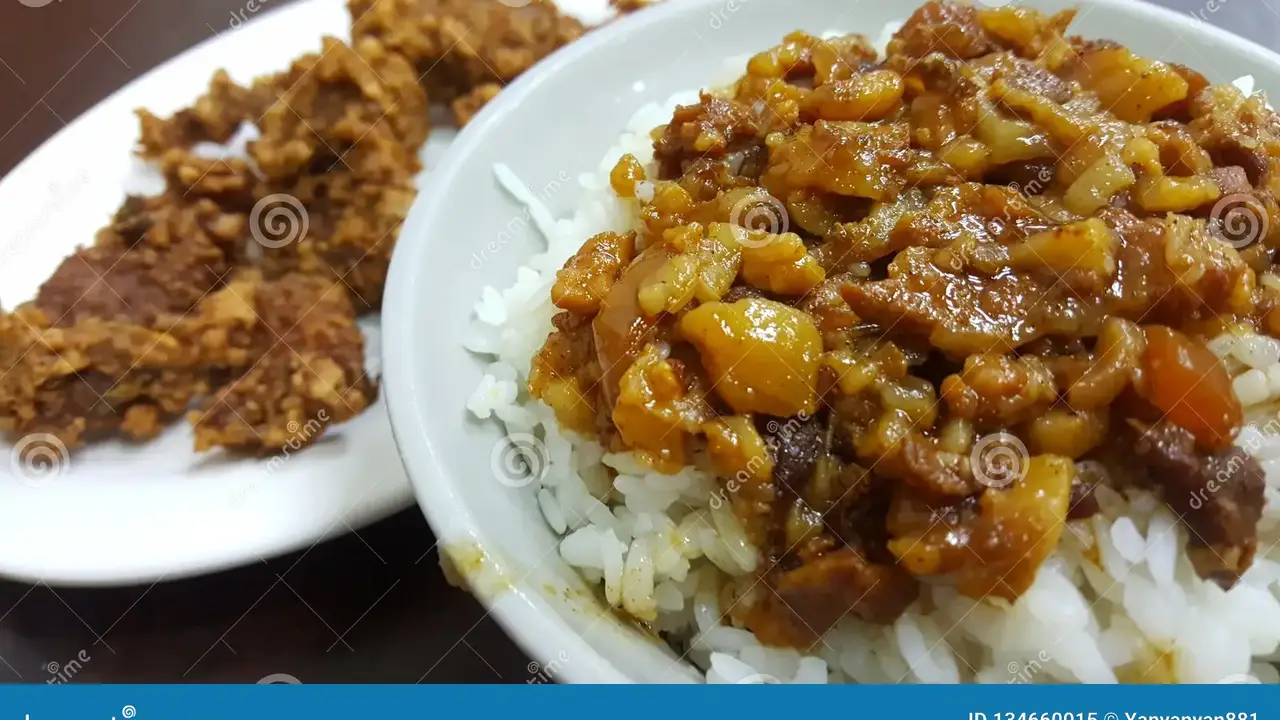Taiwanese Rice Dishes: A Staple of Taiwanese Cuisine
Sample meta description.

Exploring the Heart of Taiwanese Cuisine Rice Dishes and Their Significance
Hey foodies! Let's dive headfirst into the delicious world of Taiwanese rice dishes. Rice isn't just a side dish here; it's the foundation, the canvas upon which a vibrant tapestry of flavors is painted. We're talking about more than just plain white rice – we're talking about a culinary adventure!
Lu Rou Fan Braised Pork Rice A Taiwanese Comfort Food Icon
First up, we gotta talk about Lu Rou Fan (滷肉飯) – Braised Pork Rice. This is practically the national dish, and for good reason. Imagine tender, melt-in-your-mouth pork belly, simmered in a rich, savory sauce of soy sauce, five-spice powder, and rock sugar. It's served over a bed of fluffy white rice, often topped with pickled vegetables and a braised egg. Seriously, what's not to love?
You'll find Lu Rou Fan everywhere, from night markets to fancy restaurants. Each vendor has their own secret recipe, tweaking the balance of sweet, salty, and savory to create their signature flavor. It's the ultimate comfort food, perfect for a quick lunch or a late-night snack.
Lu Rou Fan Variations Exploring Regional Braised Pork Rice Styles
Did you know there are regional variations? Some versions are sweeter, some are spicier, and some use different cuts of pork. Exploring these variations is a delicious way to experience the diversity of Taiwanese cuisine.
Taiwanese Chicken Rice (Ji Rou Fan) A Simple Yet Satisfying Delight
Next, let's talk about Ji Rou Fan (雞肉飯) – Chicken Rice. This dish is deceptively simple, but don't let that fool you. Shredded chicken, often poached or roasted, is drizzled with a savory sauce made from chicken fat, soy sauce, and sometimes fried shallots. It's served over rice and is surprisingly flavorful.
Ji Rou Fan is a staple in Chiayi, a city in southern Taiwan, but you'll find it all over the island. It's a lighter option than Lu Rou Fan, but still incredibly satisfying.
Chicken Rice Toppings and Customization Options
While traditionally just chicken and sauce, many places offer toppings like pickled ginger, bamboo shoots, or a soft-boiled egg to elevate your Ji Rou Fan experience.
Oyster Omelet (O-A-Jian) A Night Market Sensation
Now, for something completely different – O-A-Jian (蚵仔煎) – Oyster Omelet. This isn't your typical omelet. It's a starchy, savory pancake made with sweet potato starch, eggs, oysters, and leafy greens. It's cooked on a hot griddle and topped with a sweet and tangy sauce.
O-A-Jian is a quintessential night market dish, and it's a must-try for any visitor to Taiwan. The combination of textures and flavors is simply irresistible.
The Art of the Perfect Oyster Omelet Ingredient Quality and Cooking Techniques
The key to a great O-A-Jian is fresh oysters and a skilled cook who can achieve the perfect balance of crispy and chewy. The sauce is also crucial, and each vendor has their own secret recipe.
Pork Chop Rice (Pai Gu Fan) A Hearty and Flavorful Meal
Another popular rice dish is Pai Gu Fan (排骨飯) – Pork Chop Rice. A marinated pork chop, often deep-fried or pan-fried, is served over rice with various side dishes, such as pickled vegetables, braised tofu, and a hard-boiled egg.
Pai Gu Fan is a hearty and satisfying meal, perfect for lunch or dinner. The pork chop is usually well-seasoned and flavorful, and the side dishes add variety and balance.
Pork Chop Marinades Exploring Different Flavor Profiles
The marinade for the pork chop varies, but common ingredients include soy sauce, garlic, ginger, and five-spice powder. Some versions are spicier, while others are sweeter.
Zongzi (Taiwanese Rice Dumplings) A Festive and Flavorful Treat
Let's not forget Zongzi (粽子) – Taiwanese Rice Dumplings. These pyramid-shaped dumplings are made with glutinous rice and various fillings, such as pork, mushrooms, dried shrimp, and salted egg yolk. They're wrapped in bamboo leaves and steamed or boiled.
Zongzi are traditionally eaten during the Dragon Boat Festival, but you can find them year-round. They're a delicious and flavorful treat, perfect for a snack or a light meal.
Zongzi Fillings and Regional Variations
The fillings for Zongzi vary depending on the region. Northern Taiwan versions often include peanuts and shiitake mushrooms, while southern Taiwan versions tend to be sweeter and include salted egg yolk.
Bibimbap (Korean Mixed Rice) Influence of Korean Cuisine on Taiwanese Rice Dishes
While not strictly Taiwanese, the influence of Korean cuisine is undeniable. Bibimbap, with its vibrant array of seasoned vegetables, meat, and a fried egg atop a bed of rice, is a popular choice in Taiwan, showcasing the island's openness to culinary influences.
Taiwanese Rice Dishes Product Recommendations, Usage Scenarios, and Price Comparisons
Okay, let's get practical. You're probably thinking, "Where can I find these amazing dishes, and how much will they cost?" Here's a breakdown:
Lu Rou Fan (Braised Pork Rice) Product Recommendations
Vendor: Jin Feng Braised Pork Rice (金峰魯肉飯)
Description: A Taipei institution known for its rich, flavorful braised pork and perfectly cooked rice.
Usage Scenario: Quick lunch, casual dinner.
Price: Small bowl around NT$40-50 (approximately $1.30-$1.60 USD).
Vendor: Formosa Chang (鬍鬚張魯肉飯)
Description: A chain restaurant offering consistently good Lu Rou Fan with a slightly sweeter flavor profile.
Usage Scenario: Convenient meal, family dining.
Price: Small bowl around NT$50-60 (approximately $1.60-$1.90 USD).
Ji Rou Fan (Chicken Rice) Product Recommendations
Vendor: Yong He Soy Milk (永和豆漿)
Description: While famous for soy milk, many locations also serve a delicious and affordable Ji Rou Fan
Usage Scenario: Quick breakfast or lunch
Price: Small bowl around NT$30-40 (approximately $1.00-$1.30 USD).
Vendor: Various Street Vendors in Chiayi
Description: The most authentic experience! Explore the street vendors in Chiayi for the best and most varied Ji Rou Fan.
Usage Scenario: Culinary adventure, experiencing local culture.
Price: Varies, but generally very affordable (NT$30-50).
O-A-Jian (Oyster Omelet) Product Recommendations
Vendor: Raohe Street Night Market (饒河街觀光夜市)
Description: Multiple vendors offering delicious O-A-Jian. Look for the ones with the longest lines – that's usually a good sign!
Usage Scenario: Night market experience, trying street food.
Price: Around NT$60-80 (approximately $1.90-$2.60 USD).
Vendor: Shilin Night Market (士林夜市)
Description: Another great night market with numerous O-A-Jian vendors.
Usage Scenario: Night market experience, trying street food.
Price: Around NT$60-80 (approximately $1.90-$2.60 USD).
Product Comparison: Lu Rou Fan vs. Ji Rou Fan
Flavor Profile: Lu Rou Fan is richer and more savory, while Ji Rou Fan is lighter and more delicate.
Texture: Lu Rou Fan features tender, fatty pork, while Ji Rou Fan features shredded chicken.
Price: Generally, Ji Rou Fan is slightly cheaper than Lu Rou Fan.
Overall: It really depends on your preference! If you're craving something rich and flavorful, go for Lu Rou Fan. If you want something lighter and more delicate, choose Ji Rou Fan.
Taiwanese Rice Dishes Price Range and Affordability
One of the best things about Taiwanese rice dishes is their affordability. You can easily enjoy a delicious and satisfying meal for under $5 USD. This makes them a great option for budget travelers and locals alike.
Beyond the Basics Other Notable Taiwanese Rice Dishes
We've covered some of the most popular dishes, but there's so much more to explore! Look out for dishes like:
- Braised Tofu Rice (滷豆腐飯): A vegetarian-friendly option with flavorful braised tofu.
- Three Cup Chicken Rice (三杯雞飯): Chicken cooked in a fragrant sauce of soy sauce, sesame oil, and rice wine.
Experiencing Taiwanese Rice Culture Tips for Ordering and Enjoying Rice Dishes
When ordering, don't be afraid to ask for recommendations or try something new! Many vendors will offer small samples so you can taste before you buy. Also, be sure to try the different sauces and condiments available – they can really enhance the flavor of your dish.
So there you have it! A deep dive into the delicious world of Taiwanese rice dishes. Get out there and start exploring! Your taste buds will thank you.
:max_bytes(150000):strip_icc()/277019-baked-pork-chops-with-cream-of-mushroom-soup-DDMFS-beauty-4x3-BG-7505-5762b731cf30447d9cbbbbbf387beafa.jpg)






